Smith Brothers: Tapping Into New and International Markets Report
VerifiedAdded on 2023/01/09
|17
|5038
|100
Report
AI Summary
This report, focusing on Smith Brothers, explores the complexities of international market entry for SMEs, particularly in the energy sector. It examines the global business environment, including political, economic, social, technological, legal, and environmental factors (PESTLE analysis), with a specific focus on the UK and Germany. The report analyzes opportunities and threats such as e-commerce trends, technological advancements, inadequate access to finance, and marketing linkages. It delves into trading blocs, tariff and non-tariff barriers, and the advantages and disadvantages of importing and exporting. The report also compares and contrasts various methods for SMEs to tap into international markets, assessing the pros and cons of each, providing a comprehensive overview of international market strategies.
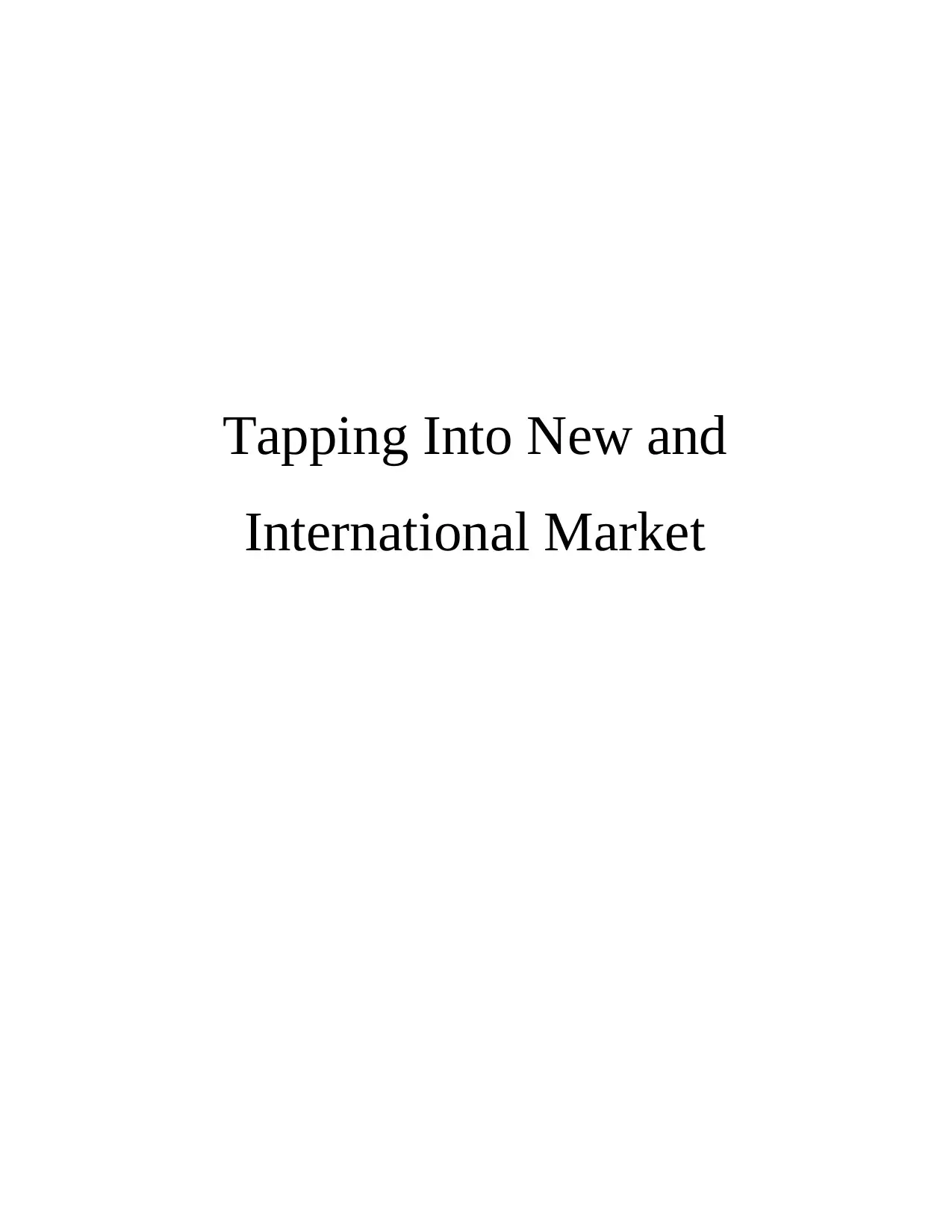
Tapping Into New and
International Market
International Market
Paraphrase This Document
Need a fresh take? Get an instant paraphrase of this document with our AI Paraphraser
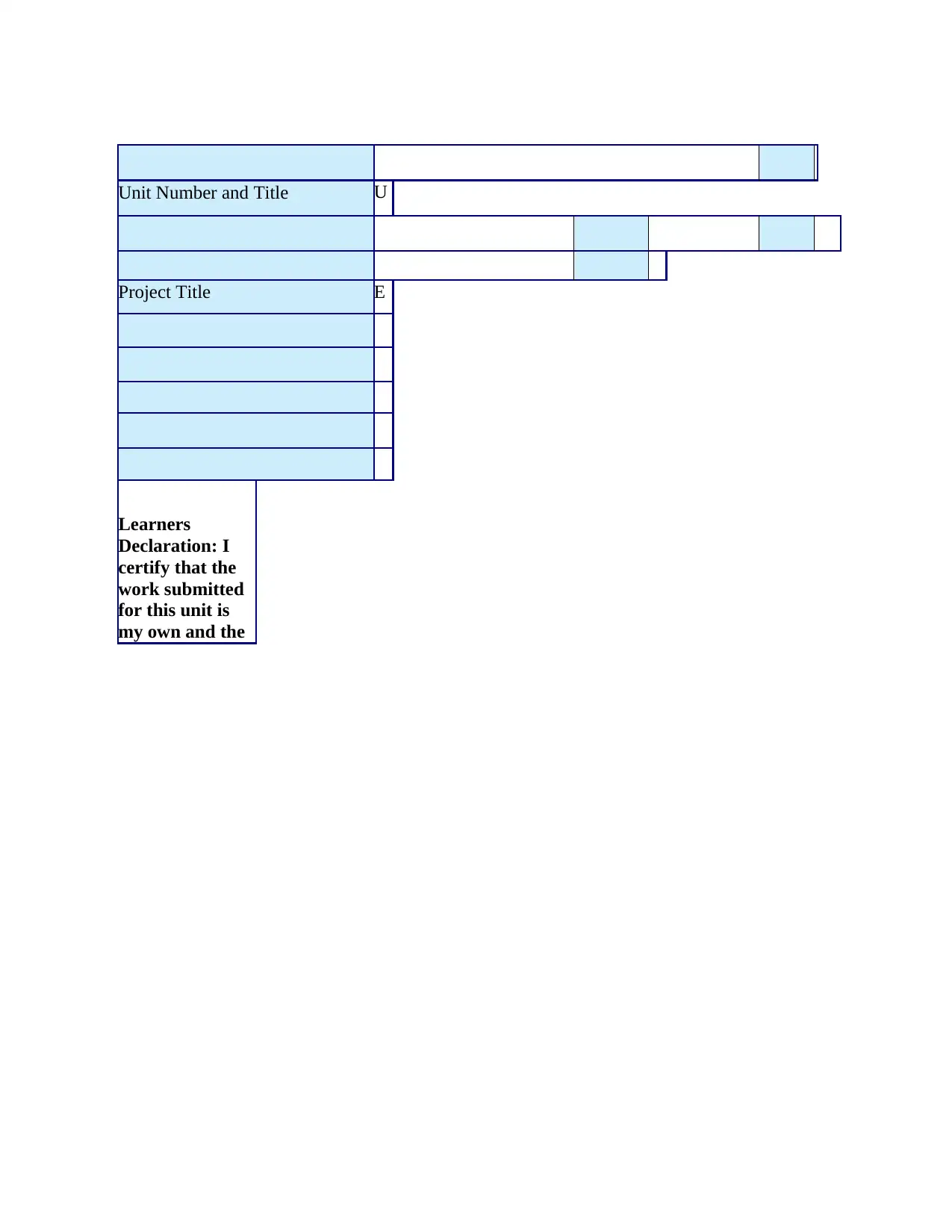
Unit Number and Title U
ni
Project Title E
xp
Learners
Declaration: I
certify that the
work submitted
for this unit is
my own and the
research sources
ni
Project Title E
xp
Learners
Declaration: I
certify that the
work submitted
for this unit is
my own and the
research sources
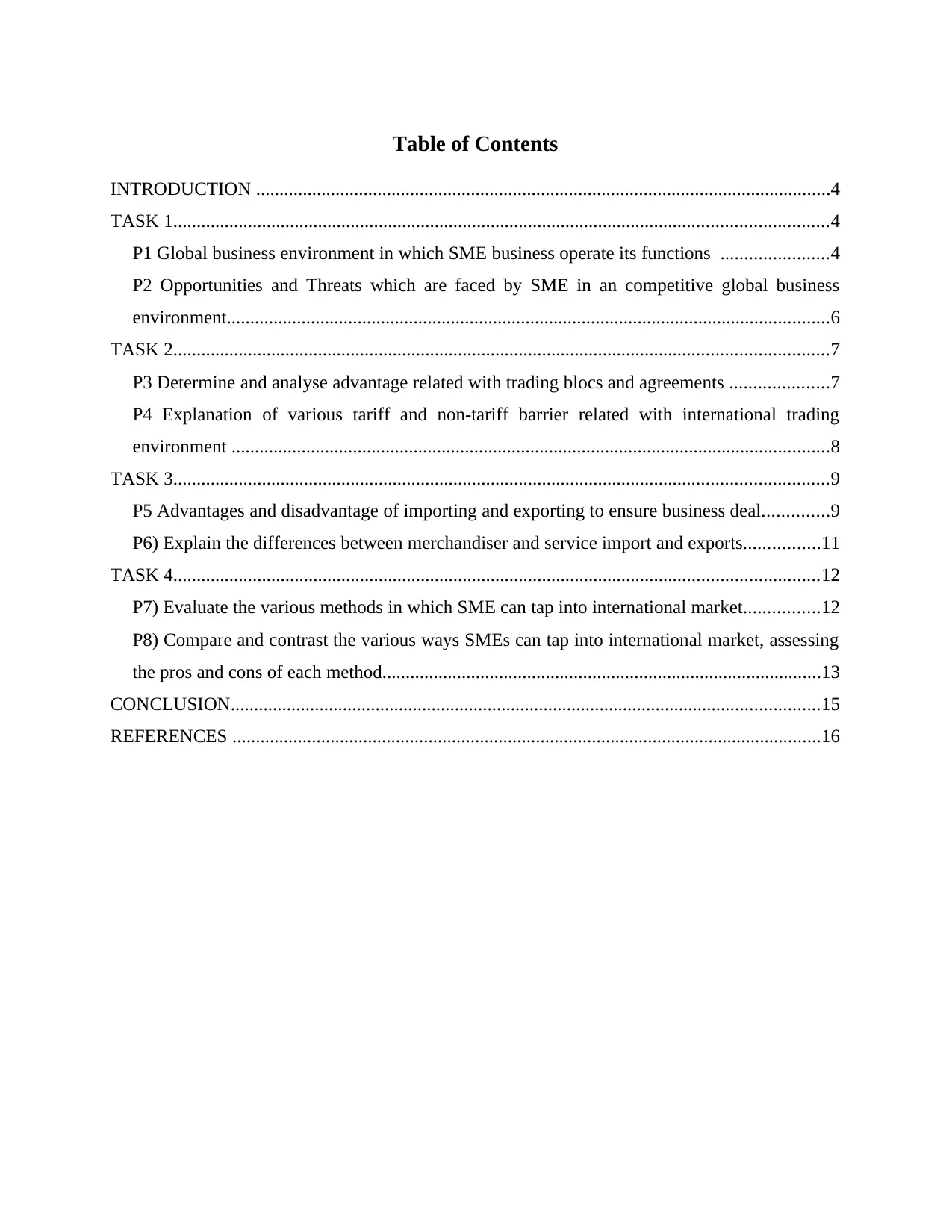
Table of Contents
INTRODUCTION ...........................................................................................................................4
TASK 1............................................................................................................................................4
P1 Global business environment in which SME business operate its functions .......................4
P2 Opportunities and Threats which are faced by SME in an competitive global business
environment.................................................................................................................................6
TASK 2............................................................................................................................................7
P3 Determine and analyse advantage related with trading blocs and agreements .....................7
P4 Explanation of various tariff and non-tariff barrier related with international trading
environment ................................................................................................................................8
TASK 3............................................................................................................................................9
P5 Advantages and disadvantage of importing and exporting to ensure business deal..............9
P6) Explain the differences between merchandiser and service import and exports................11
TASK 4..........................................................................................................................................12
P7) Evaluate the various methods in which SME can tap into international market................12
P8) Compare and contrast the various ways SMEs can tap into international market, assessing
the pros and cons of each method..............................................................................................13
CONCLUSION..............................................................................................................................15
REFERENCES ..............................................................................................................................16
INTRODUCTION ...........................................................................................................................4
TASK 1............................................................................................................................................4
P1 Global business environment in which SME business operate its functions .......................4
P2 Opportunities and Threats which are faced by SME in an competitive global business
environment.................................................................................................................................6
TASK 2............................................................................................................................................7
P3 Determine and analyse advantage related with trading blocs and agreements .....................7
P4 Explanation of various tariff and non-tariff barrier related with international trading
environment ................................................................................................................................8
TASK 3............................................................................................................................................9
P5 Advantages and disadvantage of importing and exporting to ensure business deal..............9
P6) Explain the differences between merchandiser and service import and exports................11
TASK 4..........................................................................................................................................12
P7) Evaluate the various methods in which SME can tap into international market................12
P8) Compare and contrast the various ways SMEs can tap into international market, assessing
the pros and cons of each method..............................................................................................13
CONCLUSION..............................................................................................................................15
REFERENCES ..............................................................................................................................16
⊘ This is a preview!⊘
Do you want full access?
Subscribe today to unlock all pages.

Trusted by 1+ million students worldwide

INTRODUCTION
Globalisation provide platform to all organisation for performing and managing functions
beyond the local market and it generate international market for each industry or sector. With
selling organisational product or service in another country management introduce the
organisation to a huge market. This report is written from perspective of Smith brothers and they
provide services in the energy sector and the recent focus of organisation is to establish their
division within international market (Zhong and et. al., 2017). Moreover, this report highlights on
global business environment in which small and entrepreneurial business operate and also threat
as well as business opportunity that exists in global business environment. International trading
blocs and agreements will also include the report along with tariff and non-tariff barrier of
international trading environment. In the last, advantages and disadvantages of importing and
exporting are focused in the upcoming report.
TASK 1
P1 Global business environment in which SME business operate its functions
The study of international business market involves and undertake different factor which is
used to understand the effects of the organisation activities that is impacted due to performing
operations into foreign market. This also defines that for accomplishing success in the foreign
market it is essential for Smith brother to enter into international business that helps in recognise
the diversity and difference between local and global environment. With the analyse of
respective organisation market conditions it is identified by management that multi-domestic
company that are independent to trade are more focused for entering global operations because it
leads business to undertake huge market area that also enhance company profits (Yahya and
Mutarubukwa, 2015). Smith Brothers can make use of PESTLE analysis so that it can evaluate
the market of UK which can help the company in strategically expanding in the market of
Germany:
PESLTE
Political- The first step relates with the political environment conditions and it include
different factors which focuses on company and it also leads to complete all task in an
appropriate manner by following the government rules and regulations. In context of
Smith brothers it works as positive environment because most of the government are
Globalisation provide platform to all organisation for performing and managing functions
beyond the local market and it generate international market for each industry or sector. With
selling organisational product or service in another country management introduce the
organisation to a huge market. This report is written from perspective of Smith brothers and they
provide services in the energy sector and the recent focus of organisation is to establish their
division within international market (Zhong and et. al., 2017). Moreover, this report highlights on
global business environment in which small and entrepreneurial business operate and also threat
as well as business opportunity that exists in global business environment. International trading
blocs and agreements will also include the report along with tariff and non-tariff barrier of
international trading environment. In the last, advantages and disadvantages of importing and
exporting are focused in the upcoming report.
TASK 1
P1 Global business environment in which SME business operate its functions
The study of international business market involves and undertake different factor which is
used to understand the effects of the organisation activities that is impacted due to performing
operations into foreign market. This also defines that for accomplishing success in the foreign
market it is essential for Smith brother to enter into international business that helps in recognise
the diversity and difference between local and global environment. With the analyse of
respective organisation market conditions it is identified by management that multi-domestic
company that are independent to trade are more focused for entering global operations because it
leads business to undertake huge market area that also enhance company profits (Yahya and
Mutarubukwa, 2015). Smith Brothers can make use of PESTLE analysis so that it can evaluate
the market of UK which can help the company in strategically expanding in the market of
Germany:
PESLTE
Political- The first step relates with the political environment conditions and it include
different factors which focuses on company and it also leads to complete all task in an
appropriate manner by following the government rules and regulations. In context of
Smith brothers it works as positive environment because most of the government are
Paraphrase This Document
Need a fresh take? Get an instant paraphrase of this document with our AI Paraphraser
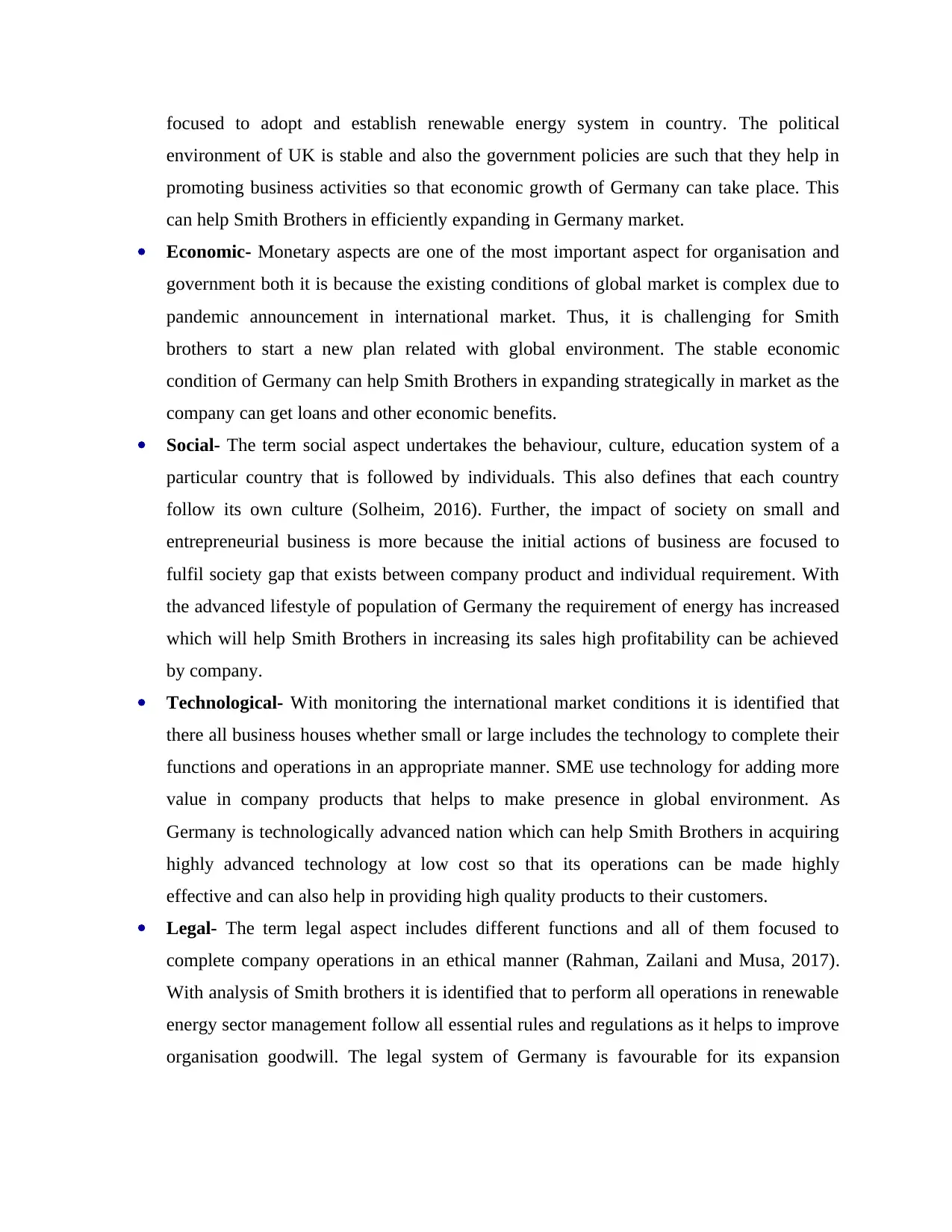
focused to adopt and establish renewable energy system in country. The political
environment of UK is stable and also the government policies are such that they help in
promoting business activities so that economic growth of Germany can take place. This
can help Smith Brothers in efficiently expanding in Germany market.
Economic- Monetary aspects are one of the most important aspect for organisation and
government both it is because the existing conditions of global market is complex due to
pandemic announcement in international market. Thus, it is challenging for Smith
brothers to start a new plan related with global environment. The stable economic
condition of Germany can help Smith Brothers in expanding strategically in market as the
company can get loans and other economic benefits.
Social- The term social aspect undertakes the behaviour, culture, education system of a
particular country that is followed by individuals. This also defines that each country
follow its own culture (Solheim, 2016). Further, the impact of society on small and
entrepreneurial business is more because the initial actions of business are focused to
fulfil society gap that exists between company product and individual requirement. With
the advanced lifestyle of population of Germany the requirement of energy has increased
which will help Smith Brothers in increasing its sales high profitability can be achieved
by company.
Technological- With monitoring the international market conditions it is identified that
there all business houses whether small or large includes the technology to complete their
functions and operations in an appropriate manner. SME use technology for adding more
value in company products that helps to make presence in global environment. As
Germany is technologically advanced nation which can help Smith Brothers in acquiring
highly advanced technology at low cost so that its operations can be made highly
effective and can also help in providing high quality products to their customers.
Legal- The term legal aspect includes different functions and all of them focused to
complete company operations in an ethical manner (Rahman, Zailani and Musa, 2017).
With analysis of Smith brothers it is identified that to perform all operations in renewable
energy sector management follow all essential rules and regulations as it helps to improve
organisation goodwill. The legal system of Germany is favourable for its expansion
environment of UK is stable and also the government policies are such that they help in
promoting business activities so that economic growth of Germany can take place. This
can help Smith Brothers in efficiently expanding in Germany market.
Economic- Monetary aspects are one of the most important aspect for organisation and
government both it is because the existing conditions of global market is complex due to
pandemic announcement in international market. Thus, it is challenging for Smith
brothers to start a new plan related with global environment. The stable economic
condition of Germany can help Smith Brothers in expanding strategically in market as the
company can get loans and other economic benefits.
Social- The term social aspect undertakes the behaviour, culture, education system of a
particular country that is followed by individuals. This also defines that each country
follow its own culture (Solheim, 2016). Further, the impact of society on small and
entrepreneurial business is more because the initial actions of business are focused to
fulfil society gap that exists between company product and individual requirement. With
the advanced lifestyle of population of Germany the requirement of energy has increased
which will help Smith Brothers in increasing its sales high profitability can be achieved
by company.
Technological- With monitoring the international market conditions it is identified that
there all business houses whether small or large includes the technology to complete their
functions and operations in an appropriate manner. SME use technology for adding more
value in company products that helps to make presence in global environment. As
Germany is technologically advanced nation which can help Smith Brothers in acquiring
highly advanced technology at low cost so that its operations can be made highly
effective and can also help in providing high quality products to their customers.
Legal- The term legal aspect includes different functions and all of them focused to
complete company operations in an ethical manner (Rahman, Zailani and Musa, 2017).
With analysis of Smith brothers it is identified that to perform all operations in renewable
energy sector management follow all essential rules and regulations as it helps to improve
organisation goodwill. The legal system of Germany is favourable for its expansion
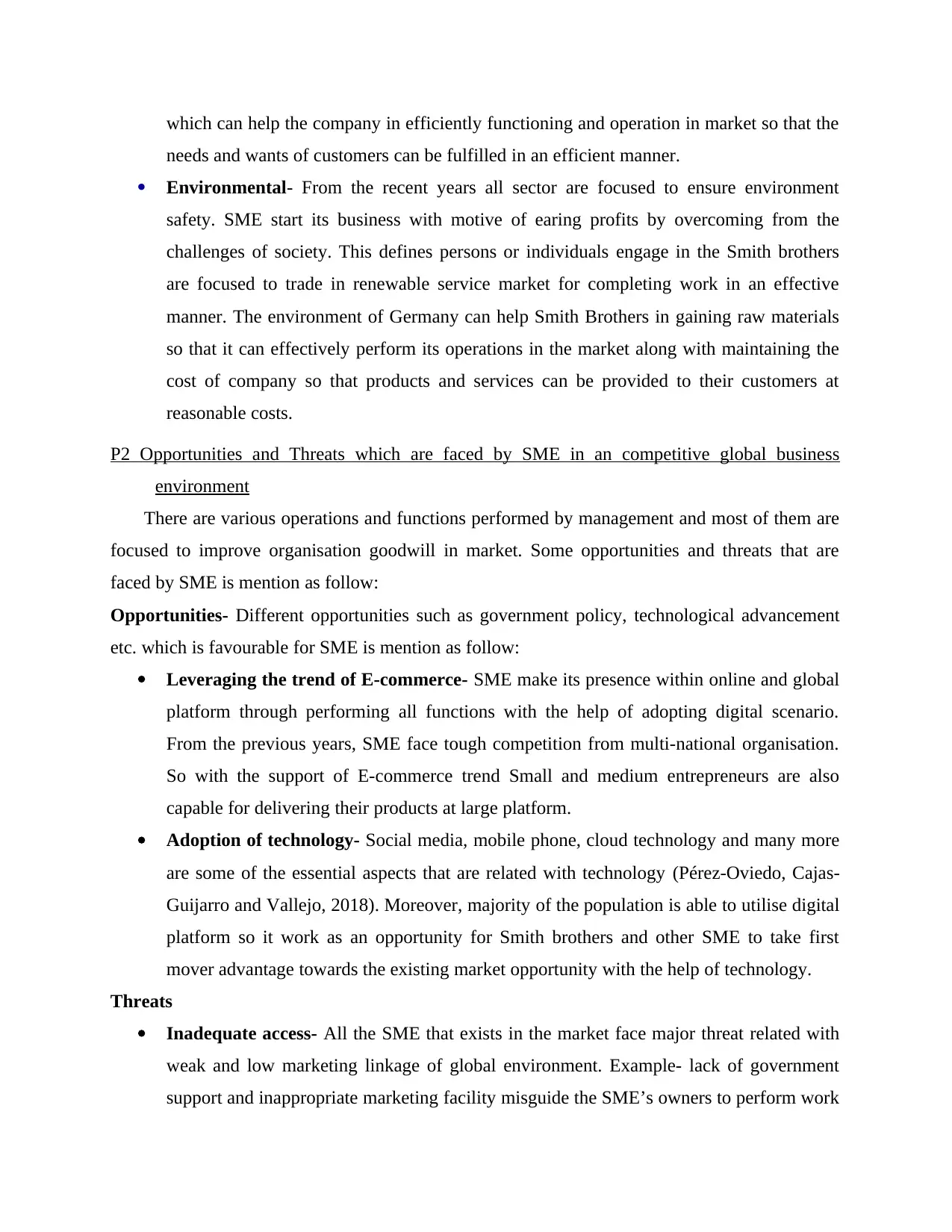
which can help the company in efficiently functioning and operation in market so that the
needs and wants of customers can be fulfilled in an efficient manner.
Environmental- From the recent years all sector are focused to ensure environment
safety. SME start its business with motive of earing profits by overcoming from the
challenges of society. This defines persons or individuals engage in the Smith brothers
are focused to trade in renewable service market for completing work in an effective
manner. The environment of Germany can help Smith Brothers in gaining raw materials
so that it can effectively perform its operations in the market along with maintaining the
cost of company so that products and services can be provided to their customers at
reasonable costs.
P2 Opportunities and Threats which are faced by SME in an competitive global business
environment
There are various operations and functions performed by management and most of them are
focused to improve organisation goodwill in market. Some opportunities and threats that are
faced by SME is mention as follow:
Opportunities- Different opportunities such as government policy, technological advancement
etc. which is favourable for SME is mention as follow:
Leveraging the trend of E-commerce- SME make its presence within online and global
platform through performing all functions with the help of adopting digital scenario.
From the previous years, SME face tough competition from multi-national organisation.
So with the support of E-commerce trend Small and medium entrepreneurs are also
capable for delivering their products at large platform.
Adoption of technology- Social media, mobile phone, cloud technology and many more
are some of the essential aspects that are related with technology (Pérez-Oviedo, Cajas-
Guijarro and Vallejo, 2018). Moreover, majority of the population is able to utilise digital
platform so it work as an opportunity for Smith brothers and other SME to take first
mover advantage towards the existing market opportunity with the help of technology.
Threats
Inadequate access- All the SME that exists in the market face major threat related with
weak and low marketing linkage of global environment. Example- lack of government
support and inappropriate marketing facility misguide the SME’s owners to perform work
needs and wants of customers can be fulfilled in an efficient manner.
Environmental- From the recent years all sector are focused to ensure environment
safety. SME start its business with motive of earing profits by overcoming from the
challenges of society. This defines persons or individuals engage in the Smith brothers
are focused to trade in renewable service market for completing work in an effective
manner. The environment of Germany can help Smith Brothers in gaining raw materials
so that it can effectively perform its operations in the market along with maintaining the
cost of company so that products and services can be provided to their customers at
reasonable costs.
P2 Opportunities and Threats which are faced by SME in an competitive global business
environment
There are various operations and functions performed by management and most of them are
focused to improve organisation goodwill in market. Some opportunities and threats that are
faced by SME is mention as follow:
Opportunities- Different opportunities such as government policy, technological advancement
etc. which is favourable for SME is mention as follow:
Leveraging the trend of E-commerce- SME make its presence within online and global
platform through performing all functions with the help of adopting digital scenario.
From the previous years, SME face tough competition from multi-national organisation.
So with the support of E-commerce trend Small and medium entrepreneurs are also
capable for delivering their products at large platform.
Adoption of technology- Social media, mobile phone, cloud technology and many more
are some of the essential aspects that are related with technology (Pérez-Oviedo, Cajas-
Guijarro and Vallejo, 2018). Moreover, majority of the population is able to utilise digital
platform so it work as an opportunity for Smith brothers and other SME to take first
mover advantage towards the existing market opportunity with the help of technology.
Threats
Inadequate access- All the SME that exists in the market face major threat related with
weak and low marketing linkage of global environment. Example- lack of government
support and inappropriate marketing facility misguide the SME’s owners to perform work
⊘ This is a preview!⊘
Do you want full access?
Subscribe today to unlock all pages.

Trusted by 1+ million students worldwide
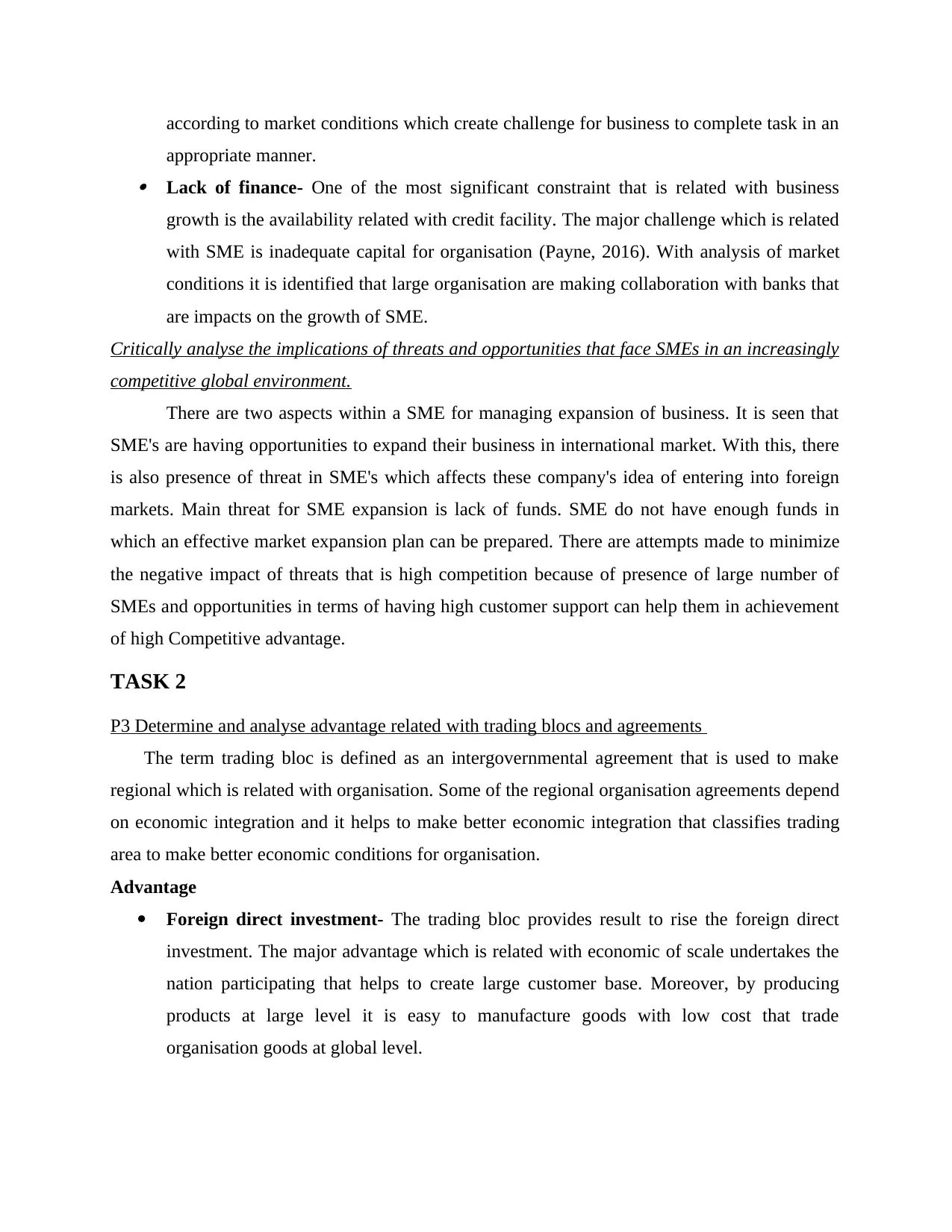
according to market conditions which create challenge for business to complete task in an
appropriate manner. Lack of finance- One of the most significant constraint that is related with business
growth is the availability related with credit facility. The major challenge which is related
with SME is inadequate capital for organisation (Payne, 2016). With analysis of market
conditions it is identified that large organisation are making collaboration with banks that
are impacts on the growth of SME.
Critically analyse the implications of threats and opportunities that face SMEs in an increasingly
competitive global environment.
There are two aspects within a SME for managing expansion of business. It is seen that
SME's are having opportunities to expand their business in international market. With this, there
is also presence of threat in SME's which affects these company's idea of entering into foreign
markets. Main threat for SME expansion is lack of funds. SME do not have enough funds in
which an effective market expansion plan can be prepared. There are attempts made to minimize
the negative impact of threats that is high competition because of presence of large number of
SMEs and opportunities in terms of having high customer support can help them in achievement
of high Competitive advantage.
TASK 2
P3 Determine and analyse advantage related with trading blocs and agreements
The term trading bloc is defined as an intergovernmental agreement that is used to make
regional which is related with organisation. Some of the regional organisation agreements depend
on economic integration and it helps to make better economic integration that classifies trading
area to make better economic conditions for organisation.
Advantage
Foreign direct investment- The trading bloc provides result to rise the foreign direct
investment. The major advantage which is related with economic of scale undertakes the
nation participating that helps to create large customer base. Moreover, by producing
products at large level it is easy to manufacture goods with low cost that trade
organisation goods at global level.
appropriate manner. Lack of finance- One of the most significant constraint that is related with business
growth is the availability related with credit facility. The major challenge which is related
with SME is inadequate capital for organisation (Payne, 2016). With analysis of market
conditions it is identified that large organisation are making collaboration with banks that
are impacts on the growth of SME.
Critically analyse the implications of threats and opportunities that face SMEs in an increasingly
competitive global environment.
There are two aspects within a SME for managing expansion of business. It is seen that
SME's are having opportunities to expand their business in international market. With this, there
is also presence of threat in SME's which affects these company's idea of entering into foreign
markets. Main threat for SME expansion is lack of funds. SME do not have enough funds in
which an effective market expansion plan can be prepared. There are attempts made to minimize
the negative impact of threats that is high competition because of presence of large number of
SMEs and opportunities in terms of having high customer support can help them in achievement
of high Competitive advantage.
TASK 2
P3 Determine and analyse advantage related with trading blocs and agreements
The term trading bloc is defined as an intergovernmental agreement that is used to make
regional which is related with organisation. Some of the regional organisation agreements depend
on economic integration and it helps to make better economic integration that classifies trading
area to make better economic conditions for organisation.
Advantage
Foreign direct investment- The trading bloc provides result to rise the foreign direct
investment. The major advantage which is related with economic of scale undertakes the
nation participating that helps to create large customer base. Moreover, by producing
products at large level it is easy to manufacture goods with low cost that trade
organisation goods at global level.
Paraphrase This Document
Need a fresh take? Get an instant paraphrase of this document with our AI Paraphraser
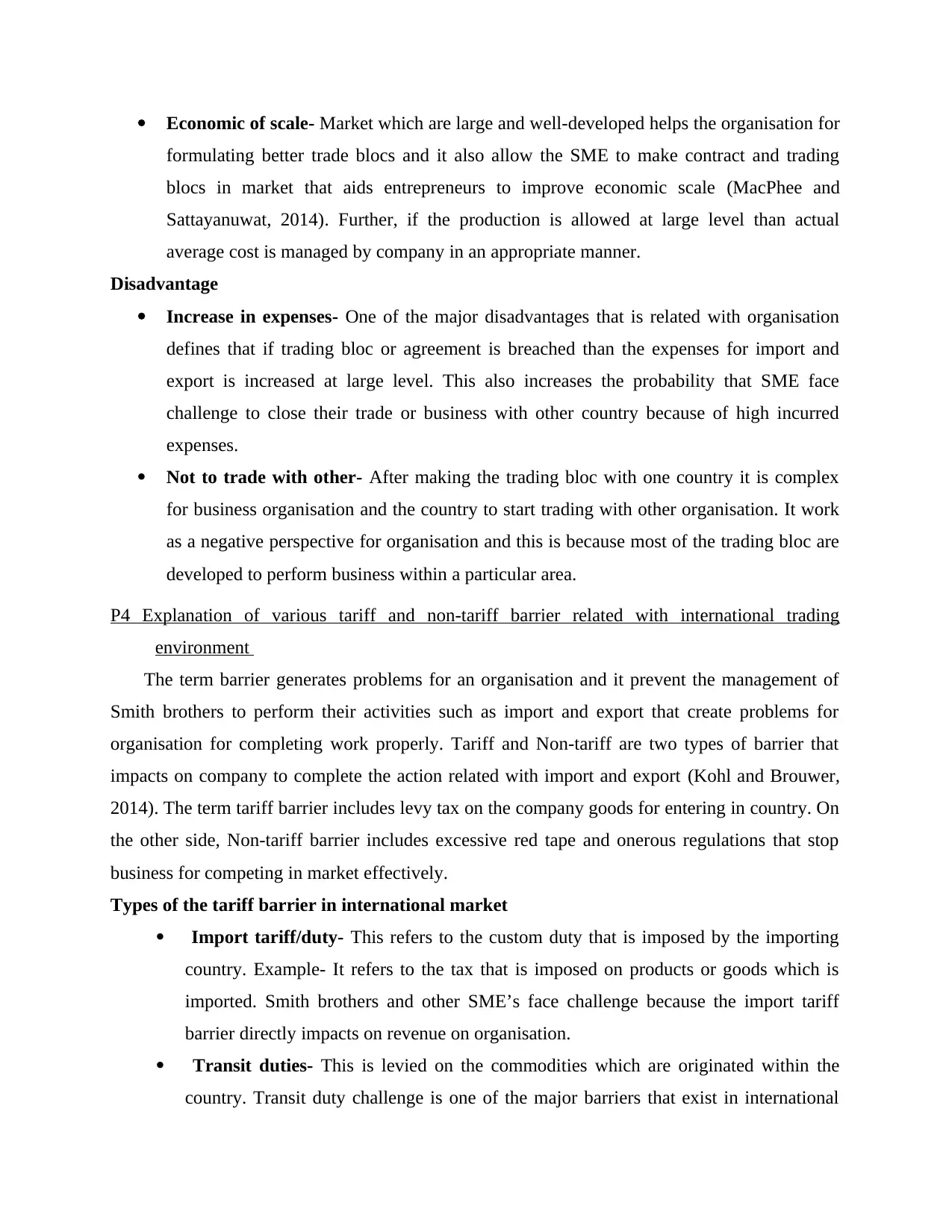
Economic of scale- Market which are large and well-developed helps the organisation for
formulating better trade blocs and it also allow the SME to make contract and trading
blocs in market that aids entrepreneurs to improve economic scale (MacPhee and
Sattayanuwat, 2014). Further, if the production is allowed at large level than actual
average cost is managed by company in an appropriate manner.
Disadvantage
Increase in expenses- One of the major disadvantages that is related with organisation
defines that if trading bloc or agreement is breached than the expenses for import and
export is increased at large level. This also increases the probability that SME face
challenge to close their trade or business with other country because of high incurred
expenses.
Not to trade with other- After making the trading bloc with one country it is complex
for business organisation and the country to start trading with other organisation. It work
as a negative perspective for organisation and this is because most of the trading bloc are
developed to perform business within a particular area.
P4 Explanation of various tariff and non-tariff barrier related with international trading
environment
The term barrier generates problems for an organisation and it prevent the management of
Smith brothers to perform their activities such as import and export that create problems for
organisation for completing work properly. Tariff and Non-tariff are two types of barrier that
impacts on company to complete the action related with import and export (Kohl and Brouwer,
2014). The term tariff barrier includes levy tax on the company goods for entering in country. On
the other side, Non-tariff barrier includes excessive red tape and onerous regulations that stop
business for competing in market effectively.
Types of the tariff barrier in international market
Import tariff/duty- This refers to the custom duty that is imposed by the importing
country. Example- It refers to the tax that is imposed on products or goods which is
imported. Smith brothers and other SME’s face challenge because the import tariff
barrier directly impacts on revenue on organisation.
Transit duties- This is levied on the commodities which are originated within the
country. Transit duty challenge is one of the major barriers that exist in international
formulating better trade blocs and it also allow the SME to make contract and trading
blocs in market that aids entrepreneurs to improve economic scale (MacPhee and
Sattayanuwat, 2014). Further, if the production is allowed at large level than actual
average cost is managed by company in an appropriate manner.
Disadvantage
Increase in expenses- One of the major disadvantages that is related with organisation
defines that if trading bloc or agreement is breached than the expenses for import and
export is increased at large level. This also increases the probability that SME face
challenge to close their trade or business with other country because of high incurred
expenses.
Not to trade with other- After making the trading bloc with one country it is complex
for business organisation and the country to start trading with other organisation. It work
as a negative perspective for organisation and this is because most of the trading bloc are
developed to perform business within a particular area.
P4 Explanation of various tariff and non-tariff barrier related with international trading
environment
The term barrier generates problems for an organisation and it prevent the management of
Smith brothers to perform their activities such as import and export that create problems for
organisation for completing work properly. Tariff and Non-tariff are two types of barrier that
impacts on company to complete the action related with import and export (Kohl and Brouwer,
2014). The term tariff barrier includes levy tax on the company goods for entering in country. On
the other side, Non-tariff barrier includes excessive red tape and onerous regulations that stop
business for competing in market effectively.
Types of the tariff barrier in international market
Import tariff/duty- This refers to the custom duty that is imposed by the importing
country. Example- It refers to the tax that is imposed on products or goods which is
imported. Smith brothers and other SME’s face challenge because the import tariff
barrier directly impacts on revenue on organisation.
Transit duties- This is levied on the commodities which are originated within the
country. Transit duty challenge is one of the major barriers that exist in international
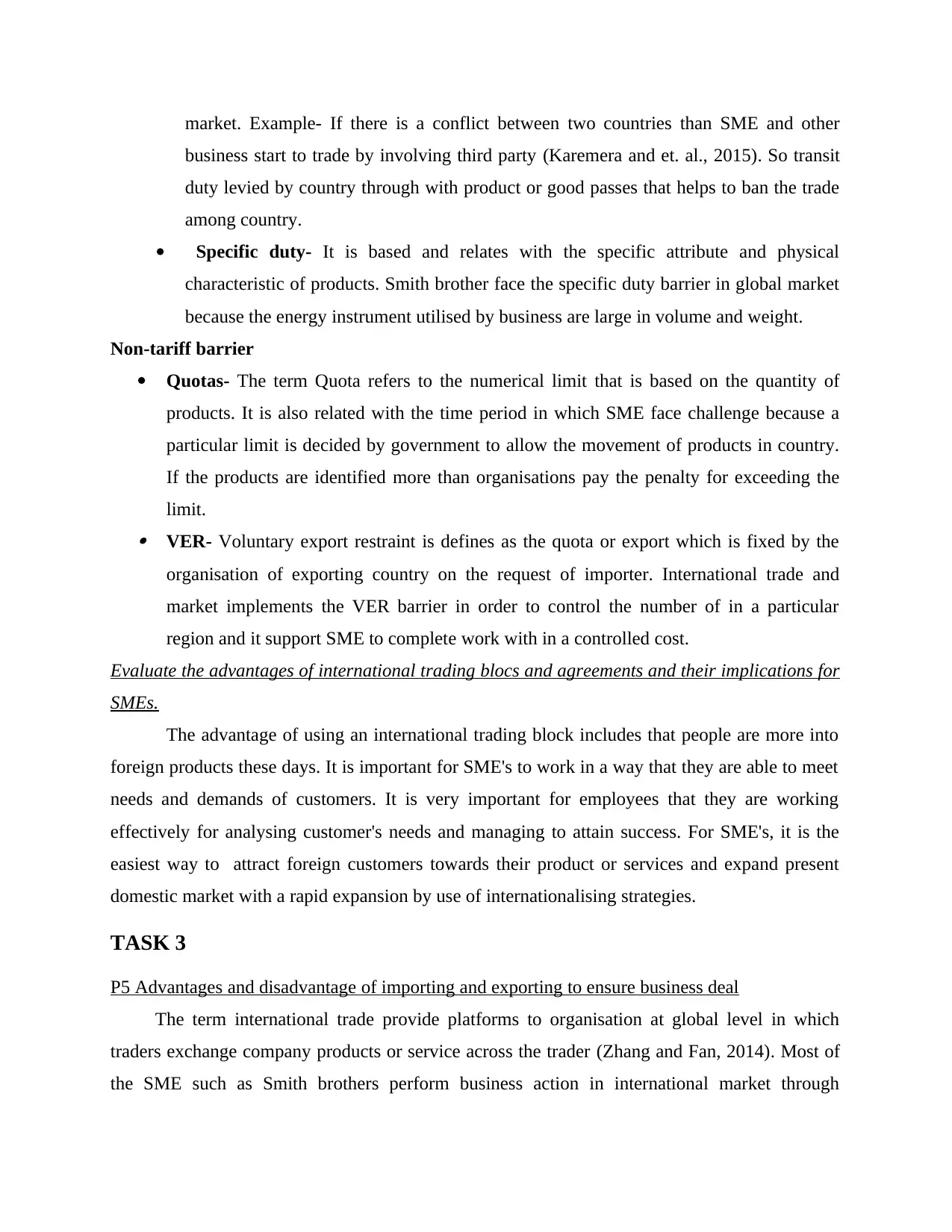
market. Example- If there is a conflict between two countries than SME and other
business start to trade by involving third party (Karemera and et. al., 2015). So transit
duty levied by country through with product or good passes that helps to ban the trade
among country.
Specific duty- It is based and relates with the specific attribute and physical
characteristic of products. Smith brother face the specific duty barrier in global market
because the energy instrument utilised by business are large in volume and weight.
Non-tariff barrier
Quotas- The term Quota refers to the numerical limit that is based on the quantity of
products. It is also related with the time period in which SME face challenge because a
particular limit is decided by government to allow the movement of products in country.
If the products are identified more than organisations pay the penalty for exceeding the
limit. VER- Voluntary export restraint is defines as the quota or export which is fixed by the
organisation of exporting country on the request of importer. International trade and
market implements the VER barrier in order to control the number of in a particular
region and it support SME to complete work with in a controlled cost.
Evaluate the advantages of international trading blocs and agreements and their implications for
SMEs.
The advantage of using an international trading block includes that people are more into
foreign products these days. It is important for SME's to work in a way that they are able to meet
needs and demands of customers. It is very important for employees that they are working
effectively for analysing customer's needs and managing to attain success. For SME's, it is the
easiest way to attract foreign customers towards their product or services and expand present
domestic market with a rapid expansion by use of internationalising strategies.
TASK 3
P5 Advantages and disadvantage of importing and exporting to ensure business deal
The term international trade provide platforms to organisation at global level in which
traders exchange company products or service across the trader (Zhang and Fan, 2014). Most of
the SME such as Smith brothers perform business action in international market through
business start to trade by involving third party (Karemera and et. al., 2015). So transit
duty levied by country through with product or good passes that helps to ban the trade
among country.
Specific duty- It is based and relates with the specific attribute and physical
characteristic of products. Smith brother face the specific duty barrier in global market
because the energy instrument utilised by business are large in volume and weight.
Non-tariff barrier
Quotas- The term Quota refers to the numerical limit that is based on the quantity of
products. It is also related with the time period in which SME face challenge because a
particular limit is decided by government to allow the movement of products in country.
If the products are identified more than organisations pay the penalty for exceeding the
limit. VER- Voluntary export restraint is defines as the quota or export which is fixed by the
organisation of exporting country on the request of importer. International trade and
market implements the VER barrier in order to control the number of in a particular
region and it support SME to complete work with in a controlled cost.
Evaluate the advantages of international trading blocs and agreements and their implications for
SMEs.
The advantage of using an international trading block includes that people are more into
foreign products these days. It is important for SME's to work in a way that they are able to meet
needs and demands of customers. It is very important for employees that they are working
effectively for analysing customer's needs and managing to attain success. For SME's, it is the
easiest way to attract foreign customers towards their product or services and expand present
domestic market with a rapid expansion by use of internationalising strategies.
TASK 3
P5 Advantages and disadvantage of importing and exporting to ensure business deal
The term international trade provide platforms to organisation at global level in which
traders exchange company products or service across the trader (Zhang and Fan, 2014). Most of
the SME such as Smith brothers perform business action in international market through
⊘ This is a preview!⊘
Do you want full access?
Subscribe today to unlock all pages.

Trusted by 1+ million students worldwide
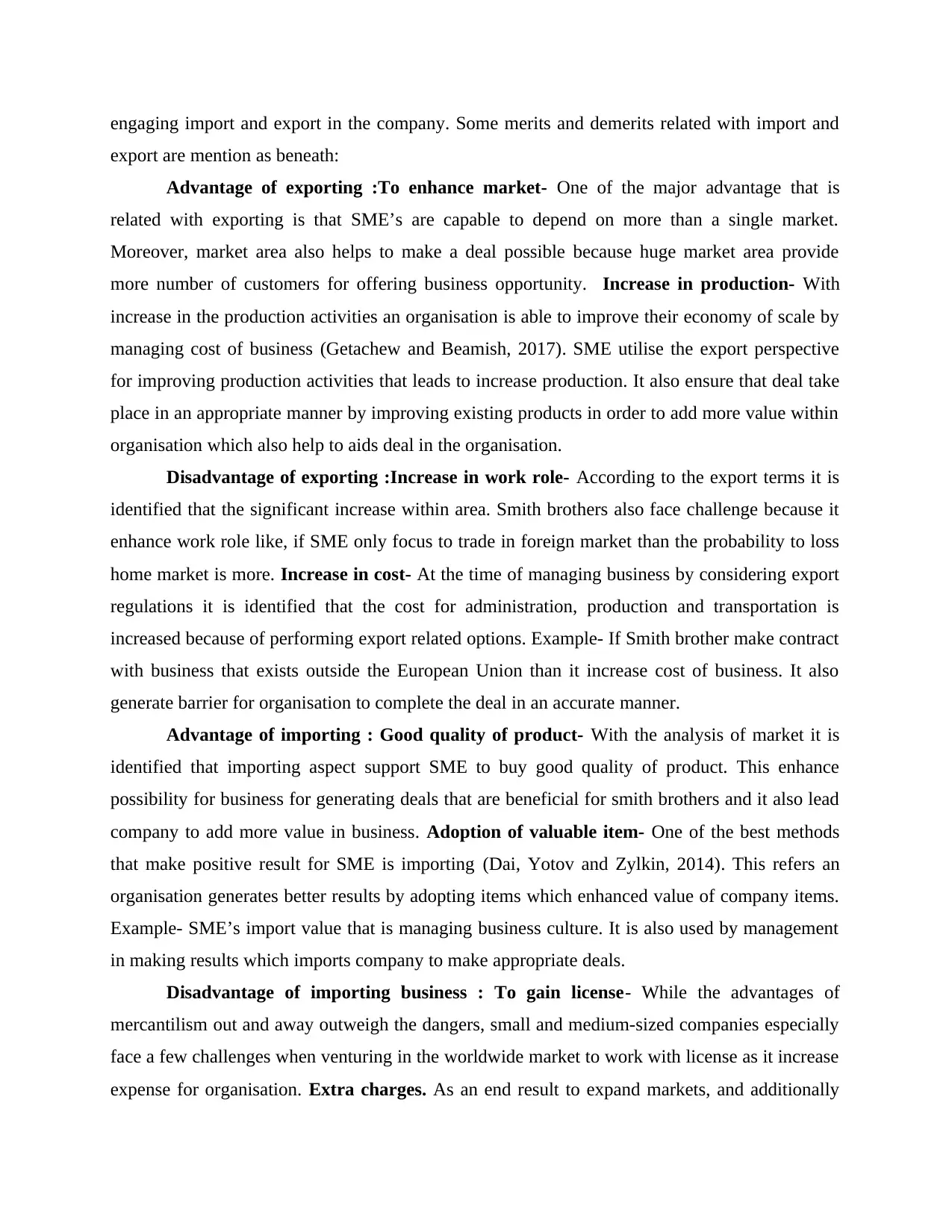
engaging import and export in the company. Some merits and demerits related with import and
export are mention as beneath:
Advantage of exporting :To enhance market- One of the major advantage that is
related with exporting is that SME’s are capable to depend on more than a single market.
Moreover, market area also helps to make a deal possible because huge market area provide
more number of customers for offering business opportunity. Increase in production- With
increase in the production activities an organisation is able to improve their economy of scale by
managing cost of business (Getachew and Beamish, 2017). SME utilise the export perspective
for improving production activities that leads to increase production. It also ensure that deal take
place in an appropriate manner by improving existing products in order to add more value within
organisation which also help to aids deal in the organisation.
Disadvantage of exporting :Increase in work role- According to the export terms it is
identified that the significant increase within area. Smith brothers also face challenge because it
enhance work role like, if SME only focus to trade in foreign market than the probability to loss
home market is more. Increase in cost- At the time of managing business by considering export
regulations it is identified that the cost for administration, production and transportation is
increased because of performing export related options. Example- If Smith brother make contract
with business that exists outside the European Union than it increase cost of business. It also
generate barrier for organisation to complete the deal in an accurate manner.
Advantage of importing : Good quality of product- With the analysis of market it is
identified that importing aspect support SME to buy good quality of product. This enhance
possibility for business for generating deals that are beneficial for smith brothers and it also lead
company to add more value in business. Adoption of valuable item- One of the best methods
that make positive result for SME is importing (Dai, Yotov and Zylkin, 2014). This refers an
organisation generates better results by adopting items which enhanced value of company items.
Example- SME’s import value that is managing business culture. It is also used by management
in making results which imports company to make appropriate deals.
Disadvantage of importing business : To gain license- While the advantages of
mercantilism out and away outweigh the dangers, small and medium-sized companies especially
face a few challenges when venturing in the worldwide market to work with license as it increase
expense for organisation. Extra charges. As an end result to expand markets, and additionally
export are mention as beneath:
Advantage of exporting :To enhance market- One of the major advantage that is
related with exporting is that SME’s are capable to depend on more than a single market.
Moreover, market area also helps to make a deal possible because huge market area provide
more number of customers for offering business opportunity. Increase in production- With
increase in the production activities an organisation is able to improve their economy of scale by
managing cost of business (Getachew and Beamish, 2017). SME utilise the export perspective
for improving production activities that leads to increase production. It also ensure that deal take
place in an appropriate manner by improving existing products in order to add more value within
organisation which also help to aids deal in the organisation.
Disadvantage of exporting :Increase in work role- According to the export terms it is
identified that the significant increase within area. Smith brothers also face challenge because it
enhance work role like, if SME only focus to trade in foreign market than the probability to loss
home market is more. Increase in cost- At the time of managing business by considering export
regulations it is identified that the cost for administration, production and transportation is
increased because of performing export related options. Example- If Smith brother make contract
with business that exists outside the European Union than it increase cost of business. It also
generate barrier for organisation to complete the deal in an accurate manner.
Advantage of importing : Good quality of product- With the analysis of market it is
identified that importing aspect support SME to buy good quality of product. This enhance
possibility for business for generating deals that are beneficial for smith brothers and it also lead
company to add more value in business. Adoption of valuable item- One of the best methods
that make positive result for SME is importing (Dai, Yotov and Zylkin, 2014). This refers an
organisation generates better results by adopting items which enhanced value of company items.
Example- SME’s import value that is managing business culture. It is also used by management
in making results which imports company to make appropriate deals.
Disadvantage of importing business : To gain license- While the advantages of
mercantilism out and away outweigh the dangers, small and medium-sized companies especially
face a few challenges when venturing in the worldwide market to work with license as it increase
expense for organisation. Extra charges. As an end result to expand markets, and additionally
Paraphrase This Document
Need a fresh take? Get an instant paraphrase of this document with our AI Paraphraser
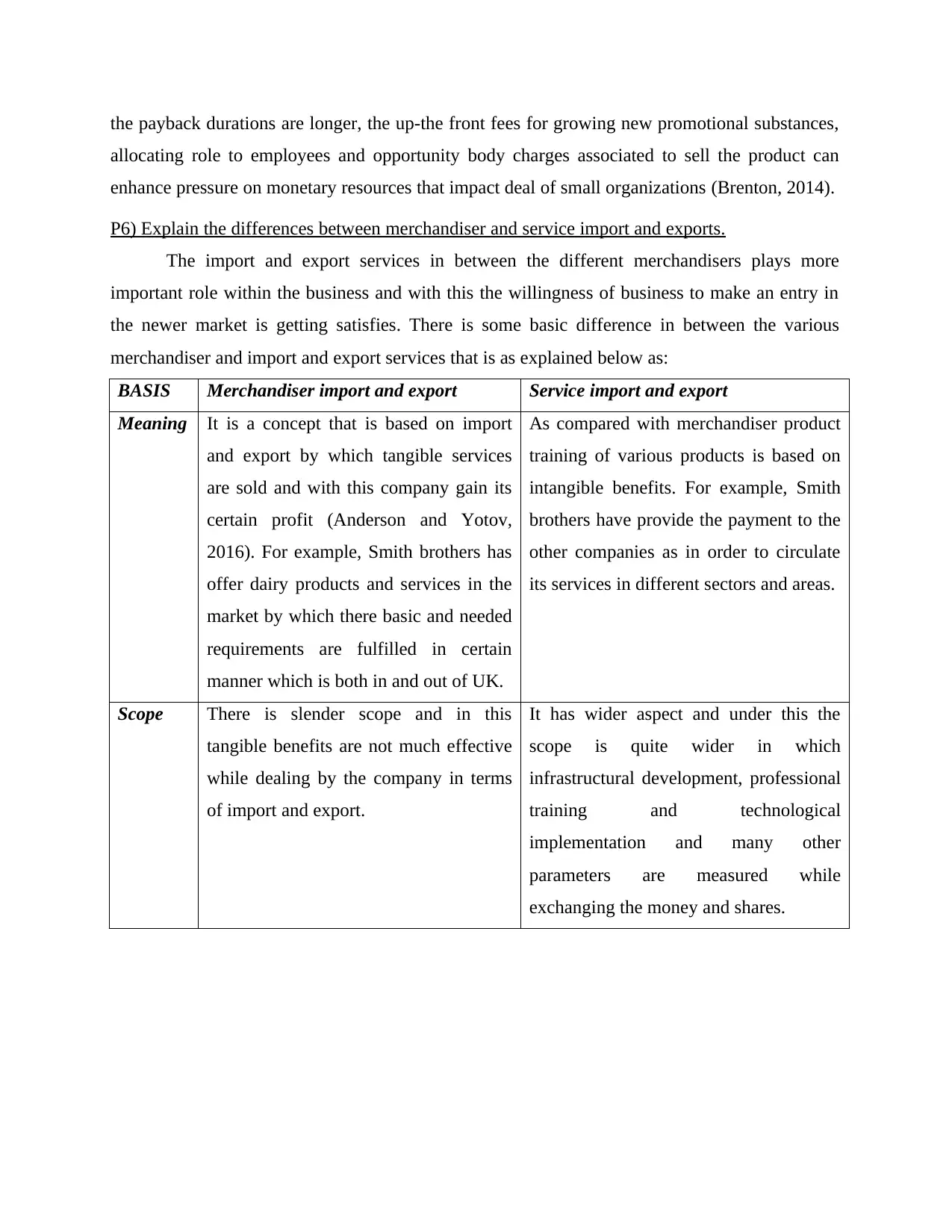
the payback durations are longer, the up-the front fees for growing new promotional substances,
allocating role to employees and opportunity body charges associated to sell the product can
enhance pressure on monetary resources that impact deal of small organizations (Brenton, 2014).
P6) Explain the differences between merchandiser and service import and exports.
The import and export services in between the different merchandisers plays more
important role within the business and with this the willingness of business to make an entry in
the newer market is getting satisfies. There is some basic difference in between the various
merchandiser and import and export services that is as explained below as:
BASIS Merchandiser import and export Service import and export
Meaning It is a concept that is based on import
and export by which tangible services
are sold and with this company gain its
certain profit (Anderson and Yotov,
2016). For example, Smith brothers has
offer dairy products and services in the
market by which there basic and needed
requirements are fulfilled in certain
manner which is both in and out of UK.
As compared with merchandiser product
training of various products is based on
intangible benefits. For example, Smith
brothers have provide the payment to the
other companies as in order to circulate
its services in different sectors and areas.
Scope There is slender scope and in this
tangible benefits are not much effective
while dealing by the company in terms
of import and export.
It has wider aspect and under this the
scope is quite wider in which
infrastructural development, professional
training and technological
implementation and many other
parameters are measured while
exchanging the money and shares.
allocating role to employees and opportunity body charges associated to sell the product can
enhance pressure on monetary resources that impact deal of small organizations (Brenton, 2014).
P6) Explain the differences between merchandiser and service import and exports.
The import and export services in between the different merchandisers plays more
important role within the business and with this the willingness of business to make an entry in
the newer market is getting satisfies. There is some basic difference in between the various
merchandiser and import and export services that is as explained below as:
BASIS Merchandiser import and export Service import and export
Meaning It is a concept that is based on import
and export by which tangible services
are sold and with this company gain its
certain profit (Anderson and Yotov,
2016). For example, Smith brothers has
offer dairy products and services in the
market by which there basic and needed
requirements are fulfilled in certain
manner which is both in and out of UK.
As compared with merchandiser product
training of various products is based on
intangible benefits. For example, Smith
brothers have provide the payment to the
other companies as in order to circulate
its services in different sectors and areas.
Scope There is slender scope and in this
tangible benefits are not much effective
while dealing by the company in terms
of import and export.
It has wider aspect and under this the
scope is quite wider in which
infrastructural development, professional
training and technological
implementation and many other
parameters are measured while
exchanging the money and shares.
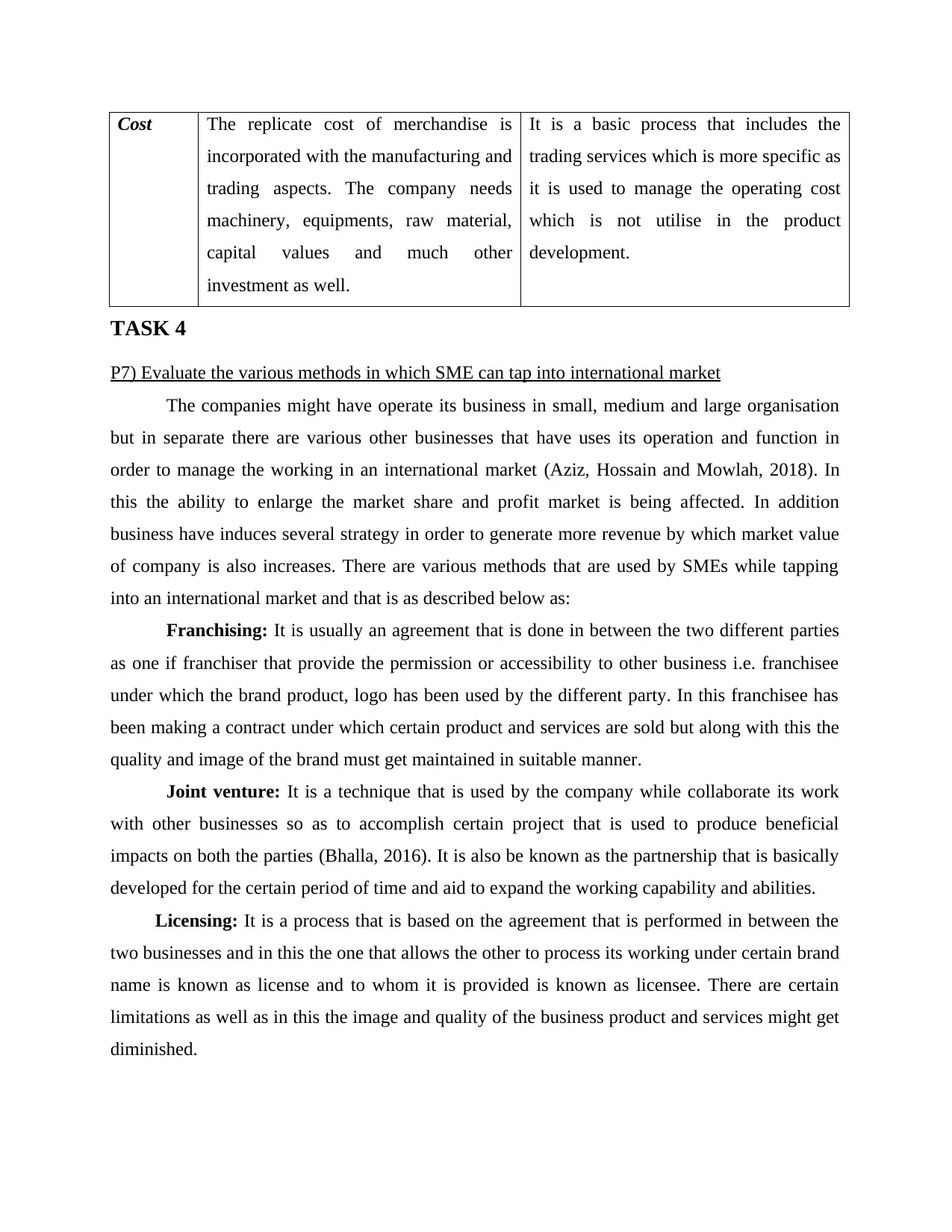
Cost The replicate cost of merchandise is
incorporated with the manufacturing and
trading aspects. The company needs
machinery, equipments, raw material,
capital values and much other
investment as well.
It is a basic process that includes the
trading services which is more specific as
it is used to manage the operating cost
which is not utilise in the product
development.
TASK 4
P7) Evaluate the various methods in which SME can tap into international market
The companies might have operate its business in small, medium and large organisation
but in separate there are various other businesses that have uses its operation and function in
order to manage the working in an international market (Aziz, Hossain and Mowlah, 2018). In
this the ability to enlarge the market share and profit market is being affected. In addition
business have induces several strategy in order to generate more revenue by which market value
of company is also increases. There are various methods that are used by SMEs while tapping
into an international market and that is as described below as:
Franchising: It is usually an agreement that is done in between the two different parties
as one if franchiser that provide the permission or accessibility to other business i.e. franchisee
under which the brand product, logo has been used by the different party. In this franchisee has
been making a contract under which certain product and services are sold but along with this the
quality and image of the brand must get maintained in suitable manner.
Joint venture: It is a technique that is used by the company while collaborate its work
with other businesses so as to accomplish certain project that is used to produce beneficial
impacts on both the parties (Bhalla, 2016). It is also be known as the partnership that is basically
developed for the certain period of time and aid to expand the working capability and abilities.
Licensing: It is a process that is based on the agreement that is performed in between the
two businesses and in this the one that allows the other to process its working under certain brand
name is known as license and to whom it is provided is known as licensee. There are certain
limitations as well as in this the image and quality of the business product and services might get
diminished.
incorporated with the manufacturing and
trading aspects. The company needs
machinery, equipments, raw material,
capital values and much other
investment as well.
It is a basic process that includes the
trading services which is more specific as
it is used to manage the operating cost
which is not utilise in the product
development.
TASK 4
P7) Evaluate the various methods in which SME can tap into international market
The companies might have operate its business in small, medium and large organisation
but in separate there are various other businesses that have uses its operation and function in
order to manage the working in an international market (Aziz, Hossain and Mowlah, 2018). In
this the ability to enlarge the market share and profit market is being affected. In addition
business have induces several strategy in order to generate more revenue by which market value
of company is also increases. There are various methods that are used by SMEs while tapping
into an international market and that is as described below as:
Franchising: It is usually an agreement that is done in between the two different parties
as one if franchiser that provide the permission or accessibility to other business i.e. franchisee
under which the brand product, logo has been used by the different party. In this franchisee has
been making a contract under which certain product and services are sold but along with this the
quality and image of the brand must get maintained in suitable manner.
Joint venture: It is a technique that is used by the company while collaborate its work
with other businesses so as to accomplish certain project that is used to produce beneficial
impacts on both the parties (Bhalla, 2016). It is also be known as the partnership that is basically
developed for the certain period of time and aid to expand the working capability and abilities.
Licensing: It is a process that is based on the agreement that is performed in between the
two businesses and in this the one that allows the other to process its working under certain brand
name is known as license and to whom it is provided is known as licensee. There are certain
limitations as well as in this the image and quality of the business product and services might get
diminished.
⊘ This is a preview!⊘
Do you want full access?
Subscribe today to unlock all pages.

Trusted by 1+ million students worldwide
1 out of 17
Related Documents
Your All-in-One AI-Powered Toolkit for Academic Success.
+13062052269
info@desklib.com
Available 24*7 on WhatsApp / Email
![[object Object]](/_next/static/media/star-bottom.7253800d.svg)
Unlock your academic potential
Copyright © 2020–2025 A2Z Services. All Rights Reserved. Developed and managed by ZUCOL.




